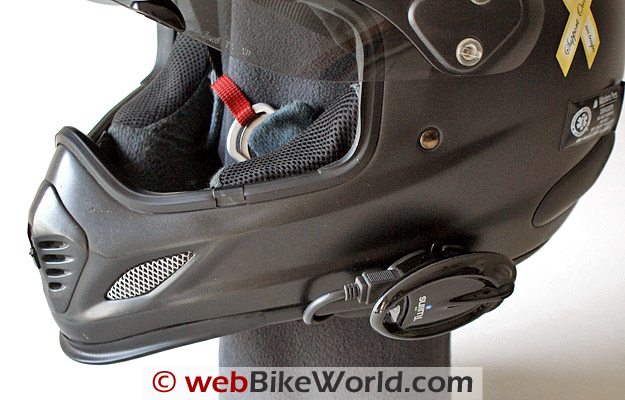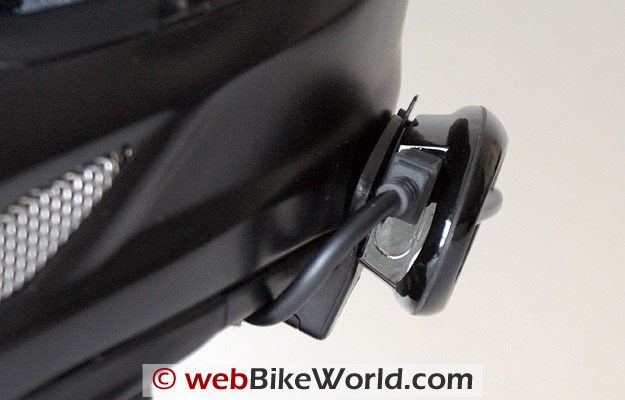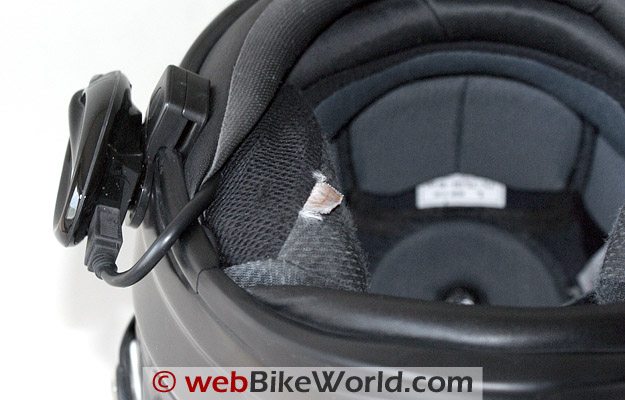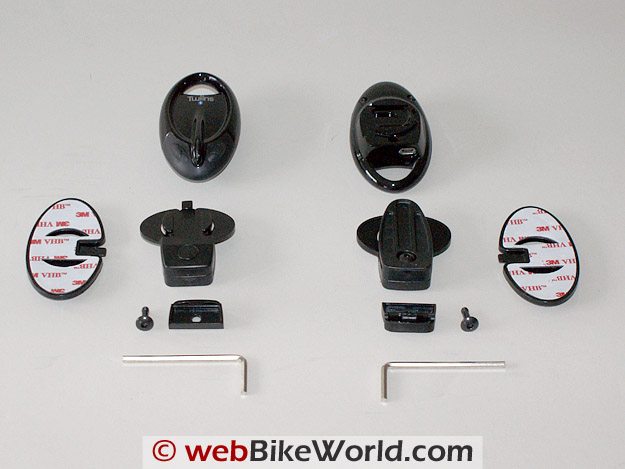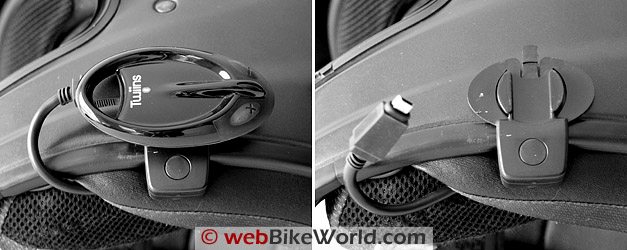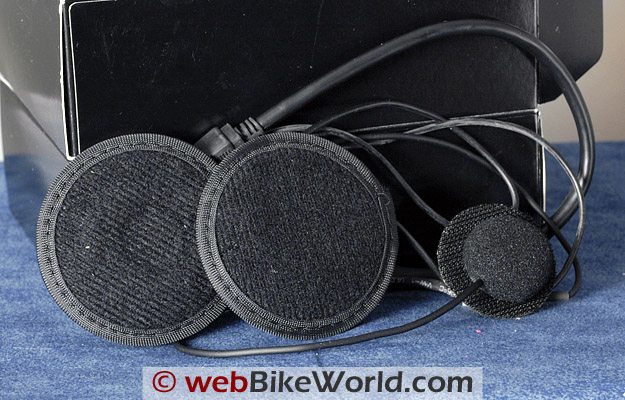Twiins is a really good basic Bluetooth communications system that provides seamless mobile phone functionality and a crystal clear intercom up to 10 metres.
It paired up instantly with every Bluetooth phone and GPS we put in front of it.
The only current shortfall, more related to self-imposed limitations (legal issues) and European marketing restrictions, is that the Twiins system does not support stereo A2DP functionality.
It apparently supports a mono audio stream given safety and legal requirements in Europe.
But even getting a mono stream has been problematic and an update will be provided if progress is made in resolving this matter.
European pricing for the Twiins system seems high and it faces stiff competition from a multitude of global challengers that support more of the media protocols provided under later Bluetooth versions.
This is an unfinished evaluation of sorts, so stay tuned.
Introduction
Twiins. The name doesn’t seem to say much, although just about everyone will get the connotation. After opening and discovering everything inside the tightly wrapped packaging and becoming familiar with the systems, the name becomes more appropriate.
It took awhile, but bundling motorcycle intercom and communications systems in pairs really seems to have caught on — and that isn’t a bad thing. Bundling provides efficiencies that can be realized by many consumers: rider-to-passenger or rider-to-rider configurations are immediate options and typically come with cost savings.
The Twiins Bluetooth Helmet Communicator headset system was developed by the MAT Group, based in Spain. The company designs and manufacturers products to order and they specialize in sports and safety equipment including helmets and clothing.
The services provided by the MAT Group range from conceptual design, engineering, testing and official approvals to manufacturing and logistics.
The Twiins system was designed for use in several sports and technology market sectors, including motorcycles.
A key phrase reflected in the Twiins marketing material is, “Communication on the move”. It is obvious that this is or is a leading principle that guided the development of this product. The device can be mounted either externally or internally, based on customer requirements and designs produced for major clients, like helmet manufacturers.
The marketing material also states that “Twiins can be connected to another helmet equipped with Twiins and every other device, such as a mobile phone, GPS, MP3, MP4 or PC using Bluetooth technology (audio transmission) without any cable or special helmet.”
So it was with these statements fresh in my mind that I started what was intended to be the first in a new series of submissions on new or updated Bluetooth communications systems currently available or coming to market this summer.
As usual however, circumstances — some of them relevant to the Twiins system itself — forced a slight change in plans, which translated into a delay of almost three weeks in completing this evaluation.
In The Box
Encased in a transparent light plastic sleeve, the compact Twiins double-sided clam-shell style container is packed to the gills with components. The highly stylized Bluetooth modules themselves are prominently displayed on the face side.
Along with the two Bluetooth modules, there are two clamp and two stick-on brackets and two headset harnesses (one thin wire microphones and one boom microphone assembly). The 220V charger has a dual head connector with mini-USB plugs so that both units can be charged concurrently.
Documentation consists of a small multi-language instruction manual and a multi-language instructional DVD based on the printed manual.
The dual-head charger is an expedient solution but it might pose issues if the two units are not used together. Let’s hope that if the Twiins intercom is to be sold in North America that it will be packaged with a compatible 110V charger or at least an adapter plug.
 Style
Style
I had some initial reservations over the styling and look of the Twiins module. But as so often happens in life, after using the system for some time, I’ve grown accustomed to its less than clunky styling and light weight. Function over Form is my typical approach and it is rare that pure styling wins the day for me…I said rarely.
The hard shiny black plastic shell looks very sleek and seems holding up well to daily use and abuse. The tactile pads that cover the two control buttons and adjacent areas are a nice touch and these, along with a sculpted horizontal molding separating the two controls makes finding the ‘minus’ and ‘plus’ controls a cinch with virtually any type of glove.
Fitment
Each Twiins intercom module consists of three basic parts: the Bluetooth module or inter-communicator; the base or mounting bracket (clamp style and adhesive); and the headset (headphones and microphone).
The headset harness is a heavy-duty affair, with junction points cleanly fashioned and totally sealed with shrink wrap material. The microphone lead plugs into the headset harness via a flat two-pin connector so that either the thin wire or boom microphone assembly can be used and changed quickly as user requirements dictate.
Each of the two thin wire microphone harnesses is 43 cm in length while the boom microphone harness is 40 cm long, with both measurements taken from the common junction point on the main headset connector harness. What I did note is that only one boom microphone was included; hopefully this was just a packing oversight.
Similar in style to those used by other brands, the clamp bracket kit includes a small extender bridge and a longer screw for use with helmets that have very hard or thick bottom edges. The trusty Arai XD3 helmet (review) hosts the first system and the bracket is mounted up in a few seconds with use of the supplied 3 mm Allen key tool.
Contrary to what is printed in the manual and stated in the DVD presentation (itself an effective visualization of the manual), the two speaker leads are the same length, 26 cm long, which makes the right side lead about 5 cm too short for a comfortable fit in my medium shell XD3.
Test fitting of the headsets into the new BMW System Six and the Nolan N-103 flip-up helmet (review) brought about the same observations: a bit more wire is needed. To offset this shortfall, especially for the XD3, I positioned the harness junction to the rear of the helmet.
With the clamp bracket installed, the Bluetooth module is forcefully slipped down on to the bracket; the pressure tang will pop in to place and hold the module securely. The headset mini-USB connectors plugs in to the USB port on the front edge – not a bad orientation, just different.
This orientation, however functional, made everything a bit tight for my installation. With the heavy duty weatherproof mini-USB connector plugged in to the main module there is no slack in anything: running the leads up inside the helmet helped somewhat.
Basic Bluetooth Configuration
With both Twiins modules plugged into the dual head charger via their USB port for initial charging, I read the instructions (twice), played the DVD media (twice) and then went searching for other information via the internet (very little).
I’m glad that the 220V to 110V adapters stay close at hand, otherwise the critical initial charging activity would have been delayed. Charging the units using the European to North American plug adapter took just under six hours. When the red LED goes out, charging is complete.
The five language instruction manual is short, but contains the essential information needed to set up and use the systems, although specific sequences are not always completely detailed. For initial setup purposes the instructions as interpreted from the manual were followed to the letter.
Turn on the system by pressing the ‘plus’ button for three seconds; the Red LED flashes and an audio tone is heard in the headset. To turn off the system, hold the same button for three to four seconds, one or both of the LEDs flash, a loud tone is heard in the headset and the system powers down.
Before going further, remember all pairing or reconfiguration changes should be from the system off state. Initial pairing of the Twiins to an external Bluetooth device is simple and as long as the devices are compatible, foolproof. Remember this comment.
Holding the ‘plus’ button for ten to twelve seconds puts the system into pairing mode as indicated by alternate flashing Red and Green LEDs and another loud tone heard in the headset. This mode stays active for 90 seconds, a period of time appreciated if the other device is not ready to go or needs to be dug out from somewhere…
Put the to-be-associated Bluetooth device into search mode and let the two devices find each other. Pairing with the tried, true but somewhat cranky HTC Touch devices went just fine – my HTC Touch found the first Twiins system in 35 seconds.
The link was subsequently secured without having to enter the default PIN code of ‘0000’. Not all devices will require this overt security step, but regardless knowing the applicable codes is a good thing.
A couple of seconds after accepting the partnership on the PDA another loud tone is heard in the helmet verifying an audio link between the two devices. Like ET, I dialed ‘home’. The audio immediately transfers to the headset and the first ring is heard in the helmet – this thing is fast.
While listening to the ever-exciting rings, I pushed the ‘minus’ button twice which serves to bring the volume down to a comfortable level. The volume range on the Twiins is quite wide, something that I came to appreciate while riding and using the systems.
After triggering the answering machine, I ended the call by pressing the ‘plus’ button for two seconds. Calls can also be ended by using the mobile phone controls or by letting the other party hang up. I find the latter easier, especially when using a Bluetooth system or mobile phone earpiece.
To redial the last number, push the ‘minus’ button for two seconds and the call out is initiated. When the helmet is removed for any period of time, this same sequence transfers the audio back to the associated phone for dismounted use.
By this point in time I had determined that all the system tones are a default LOUD — ouch! Like so many other systems on the market these tones cannot be muted or adjusted. While system warning and status tones are present for good reason, there is no reason why they cannot be adjustable (to a certain degree).
Setting up the second Twiins system with the second HTC Touch PDA device went without incident – the two devices found each other in fifteen seconds. But then her Touch has always been faster and seemingly less cranky – does this indicate something?
Mobile Phone Audio Streaming Issue
After playing with both Twiins and their paired devices for a few minutes my first red flag is realized — the only audio options presented by the HTC Touch for the Bluetooth module were ‘Earpiece’ or ‘Headset’. With the ‘Wireless Stereo’ option grayed out, it is apparent that the A2DP protocol is not supported — darn.
After posing a few questions to the Twiins representative, the necessary key information was finally provided with the representative subsequently confirming that Twiins is currently mono only due to safety reasons and legal requirements in Europe (EU market). An A2DP version may be available in the future.
This information provided some answers, but didn’t resolve the audio streaming issue, which to me, while appreciating safety and legal issues, is an important requirement for new systems coming to market.
The representative also provided other key information regarding the need to have the ‘BTAudio’ file (btaudio.sys) loaded on the mobile phone so that Twiins will recognize it for pairing and streaming purposes. This is the information I was seeking and it will now let me explore the issue further.
Pairing is not the issue here, but getting an audio stream of sorts from a mobile phone is. Accordingly, some further investigation is ongoing regarding devices and interface drivers to see if the streaming issue can be better explained or perhaps in a limited way, resolved. Stay tuned for a follow-up on this.
Just before submitting this to the Editor I was finally able to get some music audio streamed from the HTC Touch to the Twiins, but only for a few seconds at a time and only if I pushed the ‘plus’ button once quickly.
What would happen is that ten seconds of the current song would play, but then it would skip ahead to the next selection and then drop the stream.
So it seems that a mono audio stream, very weak, can be pushed from the phone to the headset, but only if an action that is normally used under the Audio/Video Remote Control Profile or AVRCP is initiated. The HTC is AVRCP compliant, but nothing in the Twiins documentation indicates that this profile is supported (yet).
I have a couple of theories about what is or is not going on, but as noted above, more investigating is needed first.
Not An Issue
But, on the positive side, with the zumo 550 paired up to either of the units, the onboard MP3 player audio is streamed perfectly, in mono, from the zumo to the headset via the Bluetooth link. Given the excellent quality of the headset, the mono feed sounded just fine with perfect balance in the helmet.
Pairing Perfection
To quote from the Twiins marketing material:
“It’s a unique product – can be associated to all mobile phones in the market with NO exceptions…Twiins supports all of the associated mobile phone’s functions – the more functions that belong to the mobile phone, the more functions available on the Twiins.”
As claimed, the systems have been very easy to pair with a number of Bluetooth capable mobile phone devices as well as both GPS units.
The list includes two HTC Touch PDA devices, a Kyocera X-tc, an LG flip phone and a Motorola i335, along with the zumo 550 and BMW Navigator III+..
In evaluating what many see as the primary function; i.e., providing a hands-free capability with a mobile phone, the Twiins pass with flying colours.
Each phone has been paired up and all of the headset or hands-free functions are supported by the headsets.
Something I really like about the system is its speed — switching is very fast and essentially seamless.
Intercom – Simple and Effective
Getting the Twiins paired to each other for the Intercom link was initially a bit frustrating. A couple of the dots were not connected so to speak in the manual and the first two efforts to get it configured using specific instructions provided by the representative didn’t pan out either.
But, as they say, try and try again. Both systems were taken back to the zero start state and then associated with one Bluetooth device to emulate the conditions outlined in the manual. With this configuration and now armed with some additional instructions provided via email by the representative, the procedure worked.
Both systems are turned off. Put one system into pairing or ‘waiting for incoming link’ mode by holding the ‘plus’ button ten to twelve seconds until the Red and Green LEDs flash alternatively.
Power the second system on by pressing the ‘plus’ button until the Red LED flashes once, then immediately push and hold its ‘-‘ button until the Red LED flashes continually, putting it into ‘search for other devices to link to’ mode.
After a few seconds, the LEDs on both systems should stop blinking, this indicates that the two systems are now linked and can be used.
The alternate setup method is used when the systems have not been paired with anything else. It basically emulates the standard Bluetooth pairing procedure, but once both units are in pairing mode, pushing and holding one of the ‘minus’ buttons will result in an audio tone being generated and the LEDs go out; the units are now ready.
Using the Twiins Intercom Function
Once configured, the intercom is easy to use. One very positive feature is that either user can initiate or terminate an intercom session. I have been so frustrated by other systems that are hard-wired and only allow the lead or rider system to initiate a session.
I suspect that both technology and feedback from customers are two leading factors in getting the hard-wired implementation changed and I for one am happy to see it.
To activate the Twiins intercom, press the ‘minus’ button on either system briefly, an initial single tone will be heard in the system indicating that a new link session is being initiated and a couple of seconds later a multi-tone sequence will be heard in the other headset.
Within another second or so, a distinct increase in the white noise level in the headsets, typical with RF systems will be heard – the link is now open.
Worth noting is that the intercom link is separate from the standard Bluetooth feature. This helps explain the concise switching and crystal clear audio. The feature is proprietary in nature so no further were provided. Bottom line? It works.
To turn off the intercom, push the ‘minus’ button again: within a second or so the link drops, confirmed by a sudden drop in background noise and a single tone heard as notification.
As with other systems on the market, the Twiins is a priority-based system. If a mobile phone call is received by either system the intercom link will be dropped while the call is handled. Once the call is terminated, the intercom session is resumed, usually in less than five seconds.
I must state that the intercom capability works well, really well actually. Its only real limitation is distance – terrain and environmental factors are negligible. Although the technology used is proprietary, its range of 10 metres or just over 30 feet is typical for a Bluetooth Class 2 (2.5mW) device.
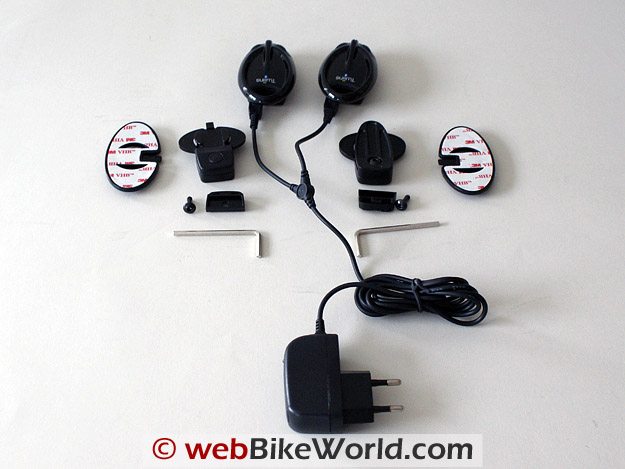
Living With Twiins
Using one of the systems on the XD3 every day for three weeks didn’t bring any major issues to light. Battery life is good or better than what is listed. I typically only have to charge the systems on alternate days.
Admittedly the systems have spent a fair bit of time on standby which reduces power consumption and extends use time. But I still feel that they are more than capable of doing a full days touring on one charge. Further data on this matter will be collected later this month while traveling south of the (Canadian) border.
System status information is ascertained by watching the LEDs or listening for specific tones. Powering up typically causes the Red LED to flash once. If the Intercom mode has been set up then the Red LED will flash every five seconds and if the Green LED is flashing every five seconds it means the Bluetooth audio is set up.
If both Red and Green LEDs are blinking at intervals on a system, it indicates that both Intercom and Mobile/GPS modes are configured and functioning. Got that?
Have I mentioned that audio quality is excellent with one of the biggest factors being the maximum output rating of 2 Watts? This is far more than what I have observed in most of the other systems available.
It is truly a pity that audio is single channel mono only. The headset speakers themselves are heavy duty and up to the task of providing clear audio with dynamic highs and lows.
Cranking up the volume, which admittedly decreases battery life, proves that this system really pumps out the sound. This observation now provides the opportunity to remind everyone to please wear ear protection of some sort – all the time.
We always use and endorse proper fitting generic or custom fitted ear protection. It is a critical part of the personal protection equipment environment.
Even with ear plugs installed there is plenty of adjustment range on the system to provide clear audio, including the intercom, at virtually any speed, as long as range limitations are observed.
As noted earlier the intercom link is not impacted by environment or terrain factors to the same degree as other systems are and being somewhat aware of the technology used, I can state that it is a big reason why the voice sessions are so good.
A Little Wear
With continued use and repeated removal of the modules I found that if the edge of the helmet and therefore the bracket is bumped the Bluetooth module can pop up off the bracket. It won’t go far though; its USB tether sees to that.
This issue is due to wearing-in between the plastic parts. When new the module was really hard to slip on and off the bracket: now it can be done with one hand and the pressure tang is far less resistive than it once was. This is an issue observed on other systems as well.
The module does sit out in the breeze a bit more than some other systems, but if it is properly seated it doesn’t move around at all, doesn’t seem to generate any noise and doesn’t interfere with riding gear.
The recent spat of wet weather which now seems to be spanning summer, north and south of the border, has been an excellent environment in which to evaluate how the Twiins module holds up to the elements.
Assessment: so far: so good, that big weatherproof USB plug is obviously doing its job. Case in point, using the Twiins in the rain on dirty roads while riding an ’09 Ducati Monster 1100 test machine subjected the module to frontal rain assaults and rear mud attacks.
In this instance having the USB connector on the front is a good thing – the back of the helmet and module were just coated with junk.
Part 2: Twiins Configuration, Specifications and Features
| wBW Review: Twiins Motorcycle Bluetooth Intercom | |
|---|---|
| Available From: Twiins Intercom | List Price: €150.00-€295.00 |
| Colour: Black | Made In: Spain |
| Review Date: August 2009 | |
Owner Comments and Feedback
See details on submitting comments.


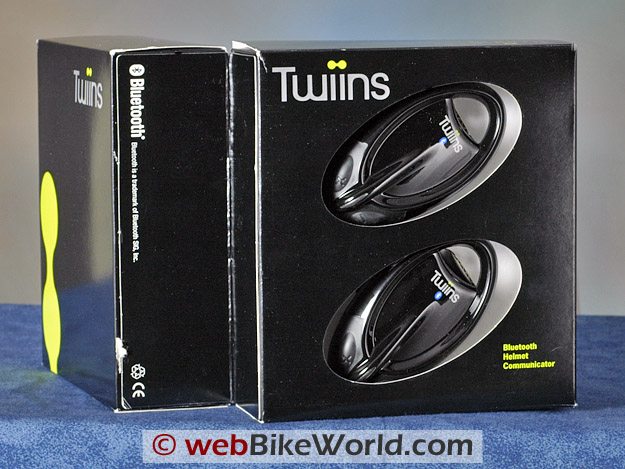

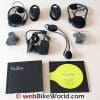
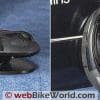
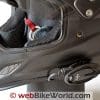
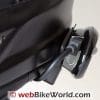

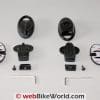


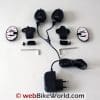
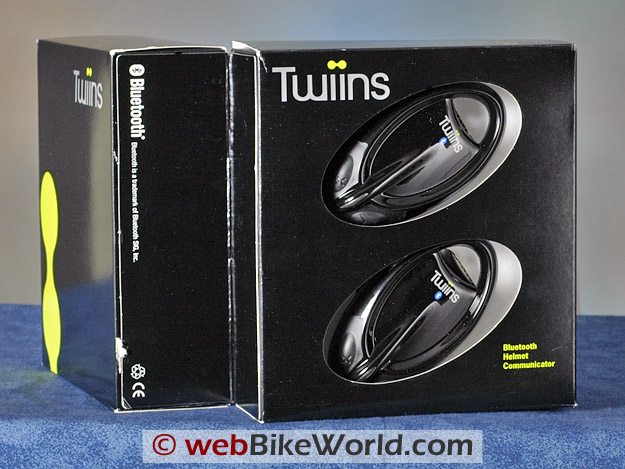
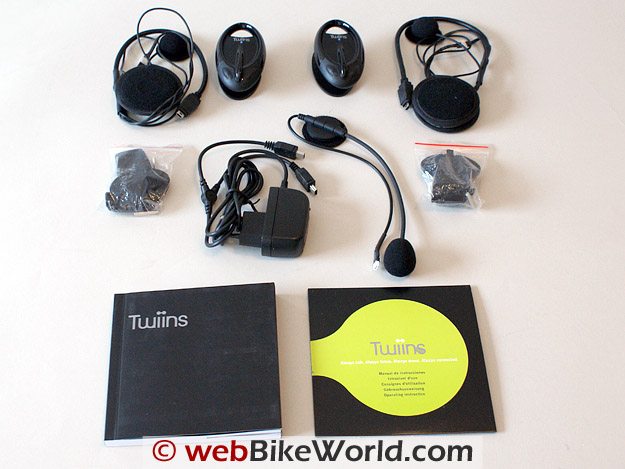
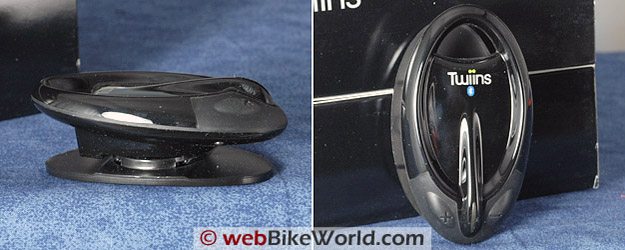 Style
Style